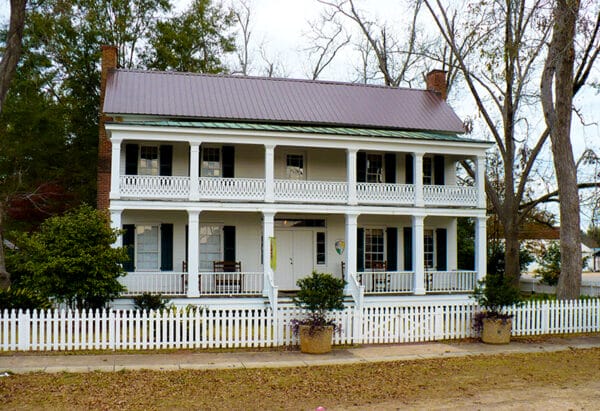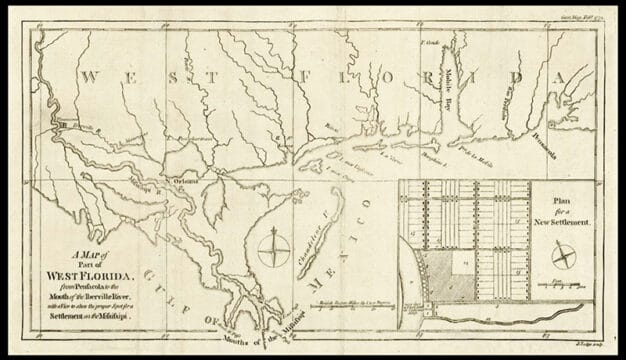Grove Hill
Located in southwest Alabama between the Alabama and Tombigbee rivers, Grove Hill is the seat of Clarke County. The area surrounding the town was settled before statehood, and the town is home to several notable historic buildings. It has a mayor-council form of government.
Early History
 Clarke County Historical Museum
The territory south of and possibly including Grove Hill was formerly inhabited by the Choctaw Indians but was claimed by the Creeks as well. A few miles from present day Grove Hill, the stockade Fort Sinquefield was built during the Creek War of 1813-14 and was the only fort attacked during the conflict. After the massacre at Fort Mims, which initiated the war, most local settlers took refuge from the Creek warriors at Fort Sinquefield. As the result of crowded conditions, however, at least two families left the shelter of the fort for their nearby farms and were attacked by Creek Indians in early September 1813; this incident became known as the Kimbell-James Massacre in which all but two of the group of women and children in these homesteads were killed. As the residents of the fort were holding funeral services for the victims just outside the fort the following day, approximately 100 Creeks again attacked the stockade as well as a group of women at a nearby spring. The settlers at the service successfully retreated into the fort, and all but one of the women at the spring were saved when Isaac Hayden led a large pack of dogs on horseback from the fort in their defense. Fort Sinquefield survived the onslaught but was soon abandoned for nearby Fort Madison.
Clarke County Historical Museum
The territory south of and possibly including Grove Hill was formerly inhabited by the Choctaw Indians but was claimed by the Creeks as well. A few miles from present day Grove Hill, the stockade Fort Sinquefield was built during the Creek War of 1813-14 and was the only fort attacked during the conflict. After the massacre at Fort Mims, which initiated the war, most local settlers took refuge from the Creek warriors at Fort Sinquefield. As the result of crowded conditions, however, at least two families left the shelter of the fort for their nearby farms and were attacked by Creek Indians in early September 1813; this incident became known as the Kimbell-James Massacre in which all but two of the group of women and children in these homesteads were killed. As the residents of the fort were holding funeral services for the victims just outside the fort the following day, approximately 100 Creeks again attacked the stockade as well as a group of women at a nearby spring. The settlers at the service successfully retreated into the fort, and all but one of the women at the spring were saved when Isaac Hayden led a large pack of dogs on horseback from the fort in their defense. Fort Sinquefield survived the onslaught but was soon abandoned for nearby Fort Madison.
The first seat of Clarke County was established in Clarkesville, but it was moved to the more centrally located Grove Hill in 1832, and a courthouse was constructed. Grove Hill was likely named for a grove of oak trees at the location. The town also had been referred to as Magoffin, Smithville, and Macon before being more consistently called Grove Hill by 1850. It grew after its establishment as the county seat, with hotels and stables to accommodate officials and travelers, but there was little industry. In addition, the town was struck by a yellow fever epidemic in 1853. The Macon Male and Female Academy was established in 1846 as the town’s first school; it later became the Grove Hill Academy and still later the Grove Hill Grammar School.
 Clarke County Courthouse
During the late nineteenth century, the timber industry became the most important segment of Grove Hill’s economy and the surrounding area, with saw mills, paper mills, and wood products manufacturing being established. The timber industry remains the most important aspect of the region’s economy today. A two-story brick courthouse was constructed in 1899 and enlarged in 1911. The town was incorporated in in 1929 and the present courthouse was constructed in 1955.
Clarke County Courthouse
During the late nineteenth century, the timber industry became the most important segment of Grove Hill’s economy and the surrounding area, with saw mills, paper mills, and wood products manufacturing being established. The timber industry remains the most important aspect of the region’s economy today. A two-story brick courthouse was constructed in 1899 and enlarged in 1911. The town was incorporated in in 1929 and the present courthouse was constructed in 1955.
Demographics
According to 2020 Census estimates, Grove Hill recorded a population of 2,011. Of that number, 62.8 percent identified themselves as white, 36.8 percent as African American, and 0.3 as two or more races. The city’s median household income was $49,018, and per capita income was $31,601.
Employment
According to 2020 Census estimates, the workforce in Grove Hill was divided among the following industrial categories:
- Educational, health and social services (24.4 percent)
- Manufacturing (21.5 percent)
- Agriculture, forestry, fishing and hunting, and extractive (13.2 percent)
- Public administration (7.8 percent)
- Retail trade (6.6 percent)
- Transportation and warehousing and utilities (5.7 percent)
- Arts, entertainment, recreation, accommodation and food services (5.0 percent)
- Professional, scientific, management, and administrative and waste management services (3.9 percent)
- Construction (3.6 percent)
- Other services except public administration (2.7 percent)
- Wholesale trade (2.6 percent)
- Finance, insurance, and real estate, rental, and leasing (2.0 percent)
- Information (1.1 percent)
Education
Public education in Grove Hill is administered by the Clarke County School District. The town has an elementary school, middle school, and high school. There is also a pre-kindergarten through 12th grade prep school.
Transportation
Grove Hill is served by U.S. 43 and State Route 13, which run north-south via State Route 295, and U.S. 84 and State Route 12, which run east-west. The Grove Hill Municipal Airport lies just southeast of town.
Events and Places of Interest
 Creagh Law Office
Grove Hill is home to a number of buildings on the National Register of Historic Places, including the Alston-Cobb House, the Bush House, the John A. Coate House, the Dickinson House, and the Grove Hill Courthouse Square Historic District. On the Alabama Register of Landmarks and Heritage are the Armistead Home, the Grant Carleton House, and the Orange Hill Road Historic District.
Creagh Law Office
Grove Hill is home to a number of buildings on the National Register of Historic Places, including the Alston-Cobb House, the Bush House, the John A. Coate House, the Dickinson House, and the Grove Hill Courthouse Square Historic District. On the Alabama Register of Landmarks and Heritage are the Armistead Home, the Grant Carleton House, and the Orange Hill Road Historic District.
The Clarke County Historical Museum, which is housed in the Alston-Cobb House (ca. 1854), is maintained by the Clarke County Historical Society. The building houses artifacts and a book store, and its grounds feature the Creagh Law Office (ca. 1834), a corn crib, and the recently restored Mathews Cabin, which dates from the 1830s. The museum hosts a Pioneer Day each October featuring pioneer-related demonstrations, including syrup making, butter churning, and wood working.
The town’s S. P. Hudson Park and Recreation Facility features ball fields, a basketball court, a playground, and other outdoor attractions. The Fort Sinquefield Historical Marker is located just south of State Route 84 between Grove Hill and Whatley on the site of the long-vanished fort, which is owned by the Fort Sinquefield Historical Association.
Additional Resources
Ball, Rev. T. H. A Glance into the Great Southeast, or, Clarke County, Alabama, and its Surroundings from 1540 to 1877. 1882. Reprint, Tuscaloosa, Ala.: Willo Publishing Company, 1962.
Graham, John Simpson. History of Clarke County. Birmingham, Ala.: Birmingham Printing Company, 1923.
Heritage of Clarke County, Alabama. Clanton, Ala.: Heritage Publishing Consultants, 2001.
Historical Sketches of Clarke County, Alabama: A Story of the Communities of Clarke County, Alabama. Huntsville, Ala.: Strode Publishers, 1977.



